Evaluating Statistical Tools for Capital Budgeting Projects
VerifiedAdded on 2022/10/19
|11
|2673
|90
Report
AI Summary
This report provides an overview of the use of statistical tools in capital budgeting. It begins by explaining the capital budgeting process and its importance in investment decisions. The report then delves into four key statistical tools: sensitivity analysis, scenario analysis, break-even analysis, and simulation. Sensitivity analysis is discussed as a method to assess how changes in key variables impact project outcomes. Scenario analysis is presented as a tool for evaluating projects under different potential future conditions. Break-even analysis is explored as a means to determine the point at which a project becomes profitable. Finally, simulation analysis is described as a method to model a range of possible outcomes and assess the probability of different scenarios. The report concludes by emphasizing the complementary nature of these tools in enhancing the quality of capital budgeting decisions.

Running head: STATISTICAL TOOLS
Statistical Tools
Name of the Student:
Name of the University:
Author Note:
Statistical Tools
Name of the Student:
Name of the University:
Author Note:
Paraphrase This Document
Need a fresh take? Get an instant paraphrase of this document with our AI Paraphraser
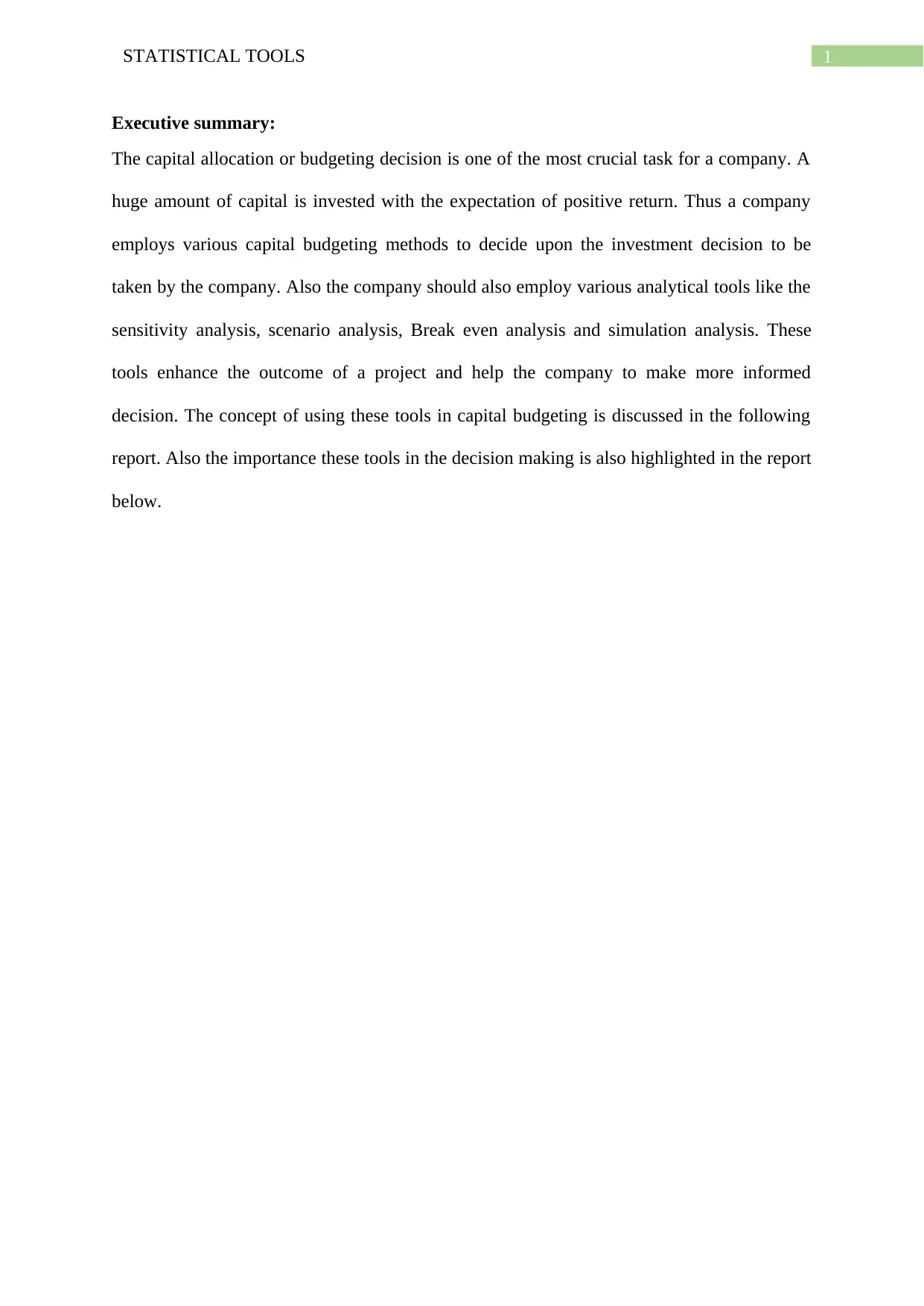
1STATISTICAL TOOLS
Executive summary:
The capital allocation or budgeting decision is one of the most crucial task for a company. A
huge amount of capital is invested with the expectation of positive return. Thus a company
employs various capital budgeting methods to decide upon the investment decision to be
taken by the company. Also the company should also employ various analytical tools like the
sensitivity analysis, scenario analysis, Break even analysis and simulation analysis. These
tools enhance the outcome of a project and help the company to make more informed
decision. The concept of using these tools in capital budgeting is discussed in the following
report. Also the importance these tools in the decision making is also highlighted in the report
below.
Executive summary:
The capital allocation or budgeting decision is one of the most crucial task for a company. A
huge amount of capital is invested with the expectation of positive return. Thus a company
employs various capital budgeting methods to decide upon the investment decision to be
taken by the company. Also the company should also employ various analytical tools like the
sensitivity analysis, scenario analysis, Break even analysis and simulation analysis. These
tools enhance the outcome of a project and help the company to make more informed
decision. The concept of using these tools in capital budgeting is discussed in the following
report. Also the importance these tools in the decision making is also highlighted in the report
below.
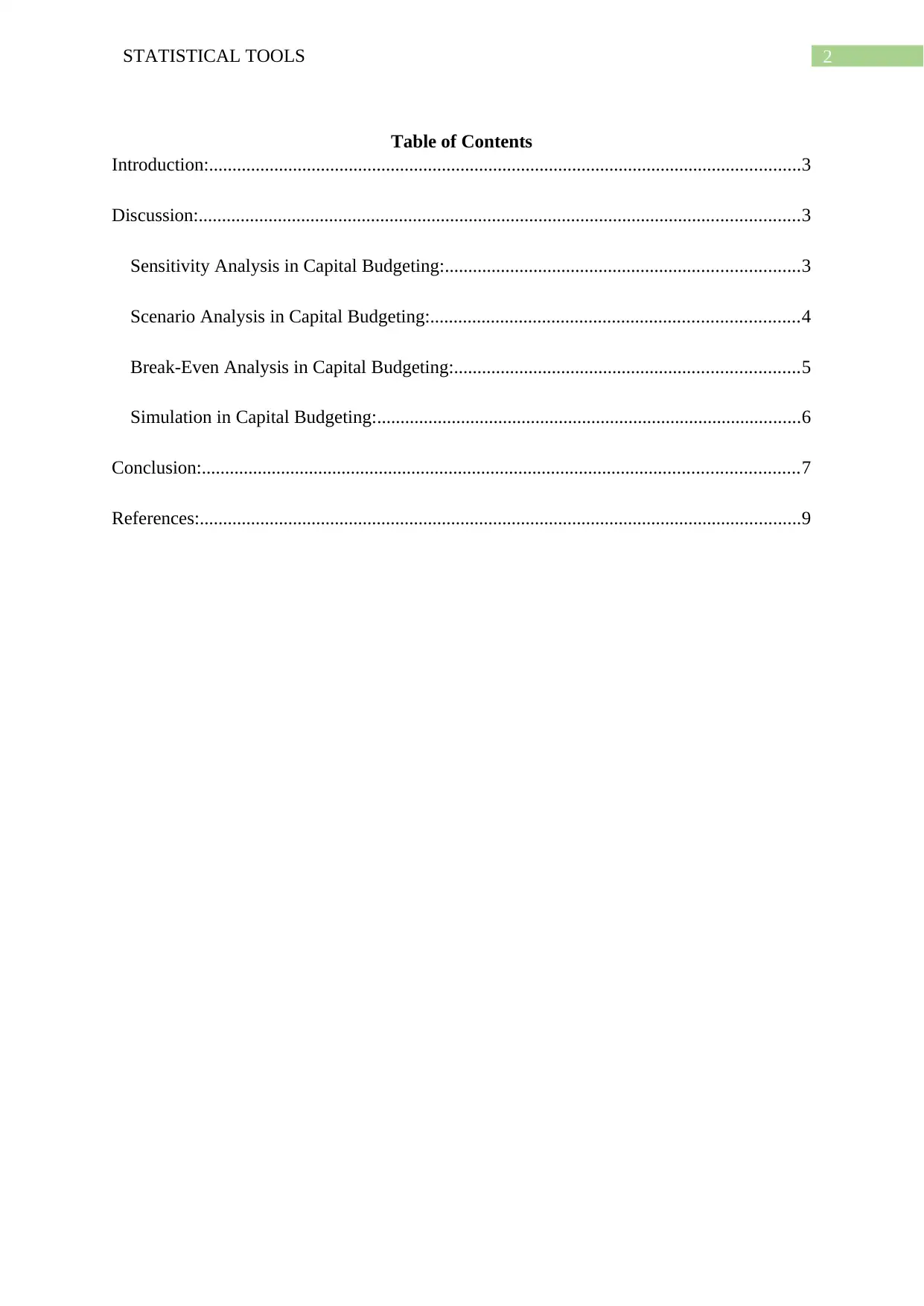
2STATISTICAL TOOLS
Table of Contents
Introduction:...............................................................................................................................3
Discussion:.................................................................................................................................3
Sensitivity Analysis in Capital Budgeting:............................................................................3
Scenario Analysis in Capital Budgeting:...............................................................................4
Break-Even Analysis in Capital Budgeting:..........................................................................5
Simulation in Capital Budgeting:...........................................................................................6
Conclusion:................................................................................................................................7
References:.................................................................................................................................9
Table of Contents
Introduction:...............................................................................................................................3
Discussion:.................................................................................................................................3
Sensitivity Analysis in Capital Budgeting:............................................................................3
Scenario Analysis in Capital Budgeting:...............................................................................4
Break-Even Analysis in Capital Budgeting:..........................................................................5
Simulation in Capital Budgeting:...........................................................................................6
Conclusion:................................................................................................................................7
References:.................................................................................................................................9
⊘ This is a preview!⊘
Do you want full access?
Subscribe today to unlock all pages.

Trusted by 1+ million students worldwide
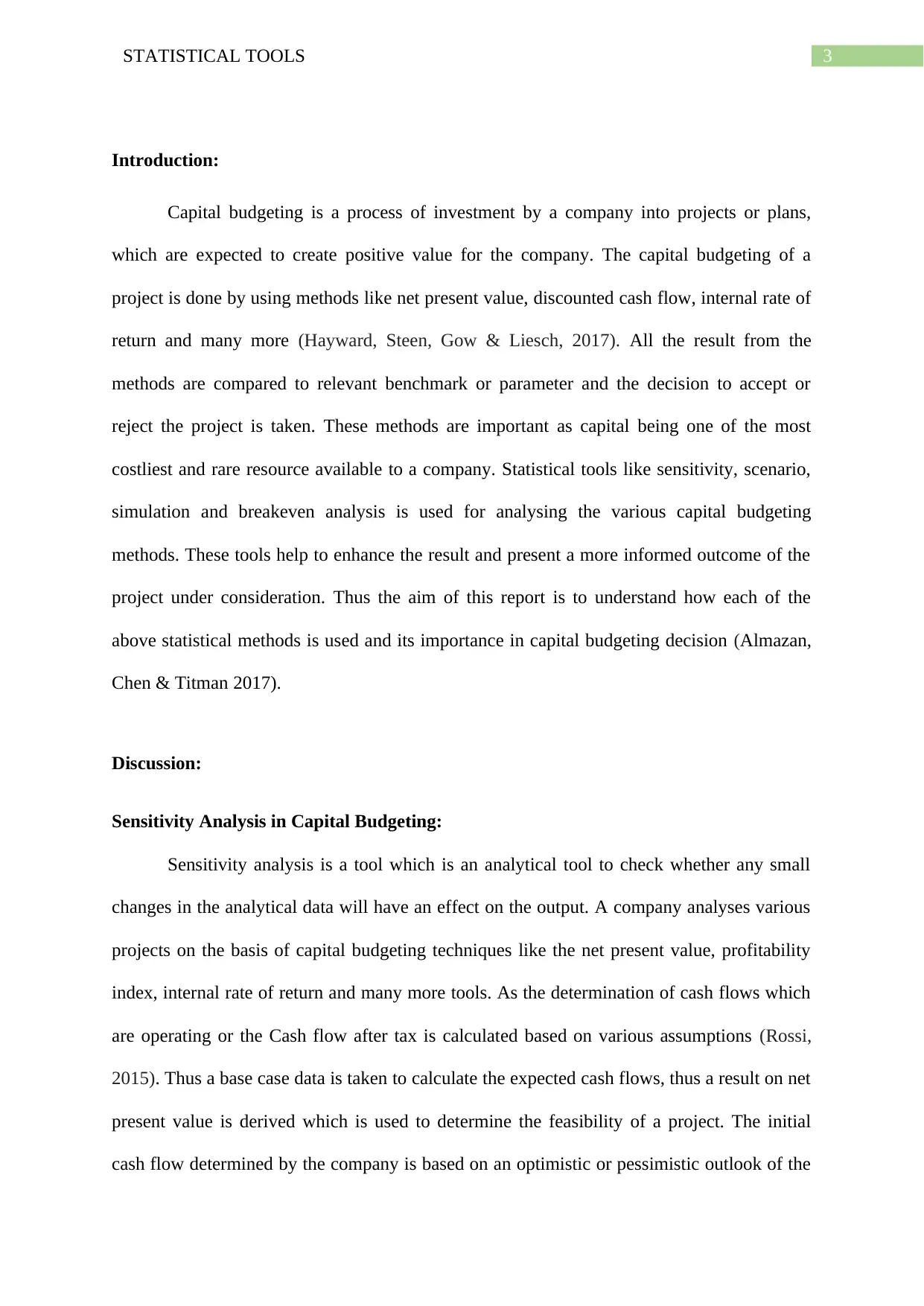
3STATISTICAL TOOLS
Introduction:
Capital budgeting is a process of investment by a company into projects or plans,
which are expected to create positive value for the company. The capital budgeting of a
project is done by using methods like net present value, discounted cash flow, internal rate of
return and many more (Hayward, Steen, Gow & Liesch, 2017). All the result from the
methods are compared to relevant benchmark or parameter and the decision to accept or
reject the project is taken. These methods are important as capital being one of the most
costliest and rare resource available to a company. Statistical tools like sensitivity, scenario,
simulation and breakeven analysis is used for analysing the various capital budgeting
methods. These tools help to enhance the result and present a more informed outcome of the
project under consideration. Thus the aim of this report is to understand how each of the
above statistical methods is used and its importance in capital budgeting decision (Almazan,
Chen & Titman 2017).
Discussion:
Sensitivity Analysis in Capital Budgeting:
Sensitivity analysis is a tool which is an analytical tool to check whether any small
changes in the analytical data will have an effect on the output. A company analyses various
projects on the basis of capital budgeting techniques like the net present value, profitability
index, internal rate of return and many more tools. As the determination of cash flows which
are operating or the Cash flow after tax is calculated based on various assumptions (Rossi,
2015). Thus a base case data is taken to calculate the expected cash flows, thus a result on net
present value is derived which is used to determine the feasibility of a project. The initial
cash flow determined by the company is based on an optimistic or pessimistic outlook of the
Introduction:
Capital budgeting is a process of investment by a company into projects or plans,
which are expected to create positive value for the company. The capital budgeting of a
project is done by using methods like net present value, discounted cash flow, internal rate of
return and many more (Hayward, Steen, Gow & Liesch, 2017). All the result from the
methods are compared to relevant benchmark or parameter and the decision to accept or
reject the project is taken. These methods are important as capital being one of the most
costliest and rare resource available to a company. Statistical tools like sensitivity, scenario,
simulation and breakeven analysis is used for analysing the various capital budgeting
methods. These tools help to enhance the result and present a more informed outcome of the
project under consideration. Thus the aim of this report is to understand how each of the
above statistical methods is used and its importance in capital budgeting decision (Almazan,
Chen & Titman 2017).
Discussion:
Sensitivity Analysis in Capital Budgeting:
Sensitivity analysis is a tool which is an analytical tool to check whether any small
changes in the analytical data will have an effect on the output. A company analyses various
projects on the basis of capital budgeting techniques like the net present value, profitability
index, internal rate of return and many more tools. As the determination of cash flows which
are operating or the Cash flow after tax is calculated based on various assumptions (Rossi,
2015). Thus a base case data is taken to calculate the expected cash flows, thus a result on net
present value is derived which is used to determine the feasibility of a project. The initial
cash flow determined by the company is based on an optimistic or pessimistic outlook of the
Paraphrase This Document
Need a fresh take? Get an instant paraphrase of this document with our AI Paraphraser
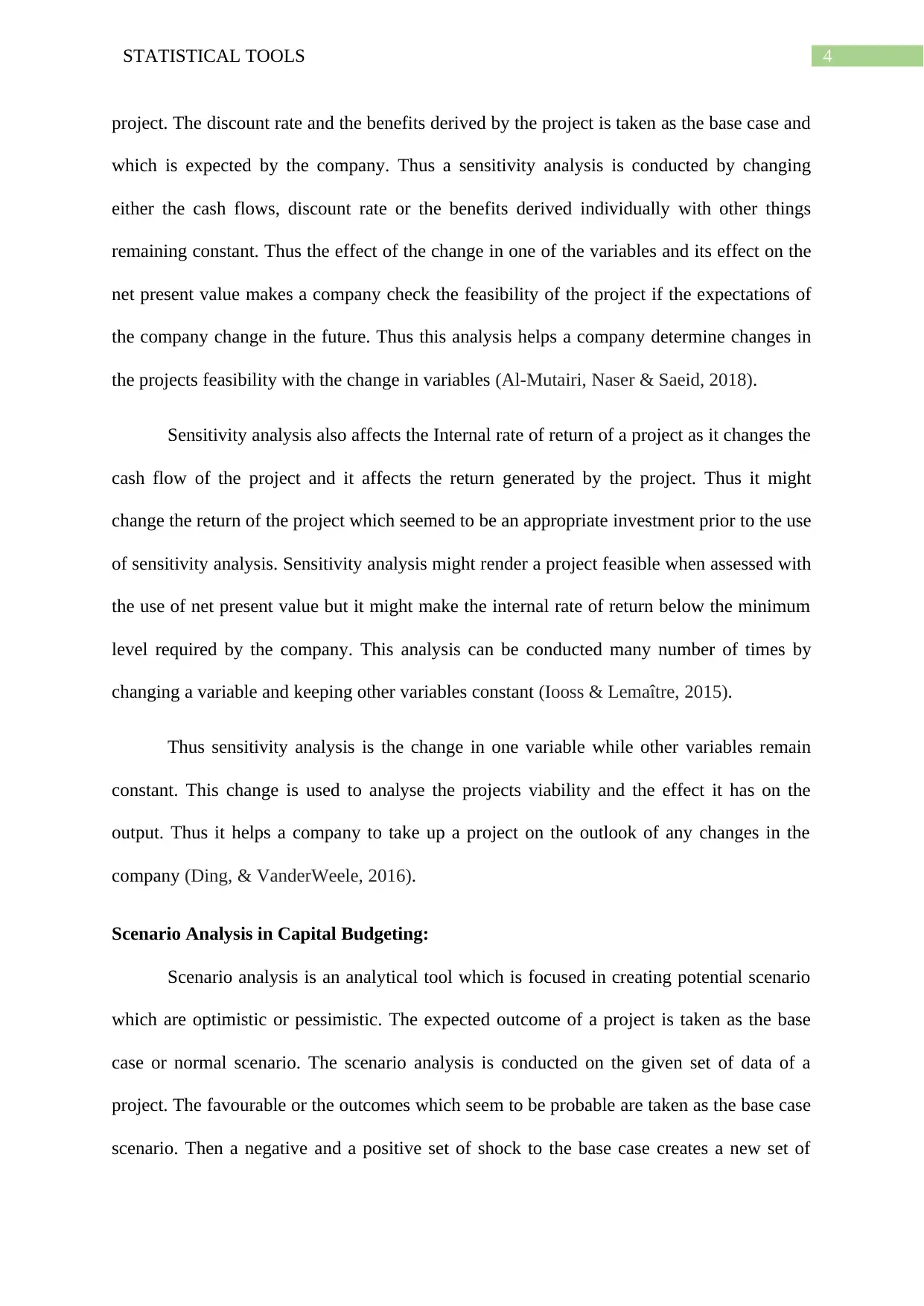
4STATISTICAL TOOLS
project. The discount rate and the benefits derived by the project is taken as the base case and
which is expected by the company. Thus a sensitivity analysis is conducted by changing
either the cash flows, discount rate or the benefits derived individually with other things
remaining constant. Thus the effect of the change in one of the variables and its effect on the
net present value makes a company check the feasibility of the project if the expectations of
the company change in the future. Thus this analysis helps a company determine changes in
the projects feasibility with the change in variables (Al-Mutairi, Naser & Saeid, 2018).
Sensitivity analysis also affects the Internal rate of return of a project as it changes the
cash flow of the project and it affects the return generated by the project. Thus it might
change the return of the project which seemed to be an appropriate investment prior to the use
of sensitivity analysis. Sensitivity analysis might render a project feasible when assessed with
the use of net present value but it might make the internal rate of return below the minimum
level required by the company. This analysis can be conducted many number of times by
changing a variable and keeping other variables constant (Iooss & Lemaître, 2015).
Thus sensitivity analysis is the change in one variable while other variables remain
constant. This change is used to analyse the projects viability and the effect it has on the
output. Thus it helps a company to take up a project on the outlook of any changes in the
company (Ding, & VanderWeele, 2016).
Scenario Analysis in Capital Budgeting:
Scenario analysis is an analytical tool which is focused in creating potential scenario
which are optimistic or pessimistic. The expected outcome of a project is taken as the base
case or normal scenario. The scenario analysis is conducted on the given set of data of a
project. The favourable or the outcomes which seem to be probable are taken as the base case
scenario. Then a negative and a positive set of shock to the base case creates a new set of
project. The discount rate and the benefits derived by the project is taken as the base case and
which is expected by the company. Thus a sensitivity analysis is conducted by changing
either the cash flows, discount rate or the benefits derived individually with other things
remaining constant. Thus the effect of the change in one of the variables and its effect on the
net present value makes a company check the feasibility of the project if the expectations of
the company change in the future. Thus this analysis helps a company determine changes in
the projects feasibility with the change in variables (Al-Mutairi, Naser & Saeid, 2018).
Sensitivity analysis also affects the Internal rate of return of a project as it changes the
cash flow of the project and it affects the return generated by the project. Thus it might
change the return of the project which seemed to be an appropriate investment prior to the use
of sensitivity analysis. Sensitivity analysis might render a project feasible when assessed with
the use of net present value but it might make the internal rate of return below the minimum
level required by the company. This analysis can be conducted many number of times by
changing a variable and keeping other variables constant (Iooss & Lemaître, 2015).
Thus sensitivity analysis is the change in one variable while other variables remain
constant. This change is used to analyse the projects viability and the effect it has on the
output. Thus it helps a company to take up a project on the outlook of any changes in the
company (Ding, & VanderWeele, 2016).
Scenario Analysis in Capital Budgeting:
Scenario analysis is an analytical tool which is focused in creating potential scenario
which are optimistic or pessimistic. The expected outcome of a project is taken as the base
case or normal scenario. The scenario analysis is conducted on the given set of data of a
project. The favourable or the outcomes which seem to be probable are taken as the base case
scenario. Then a negative and a positive set of shock to the base case creates a new set of
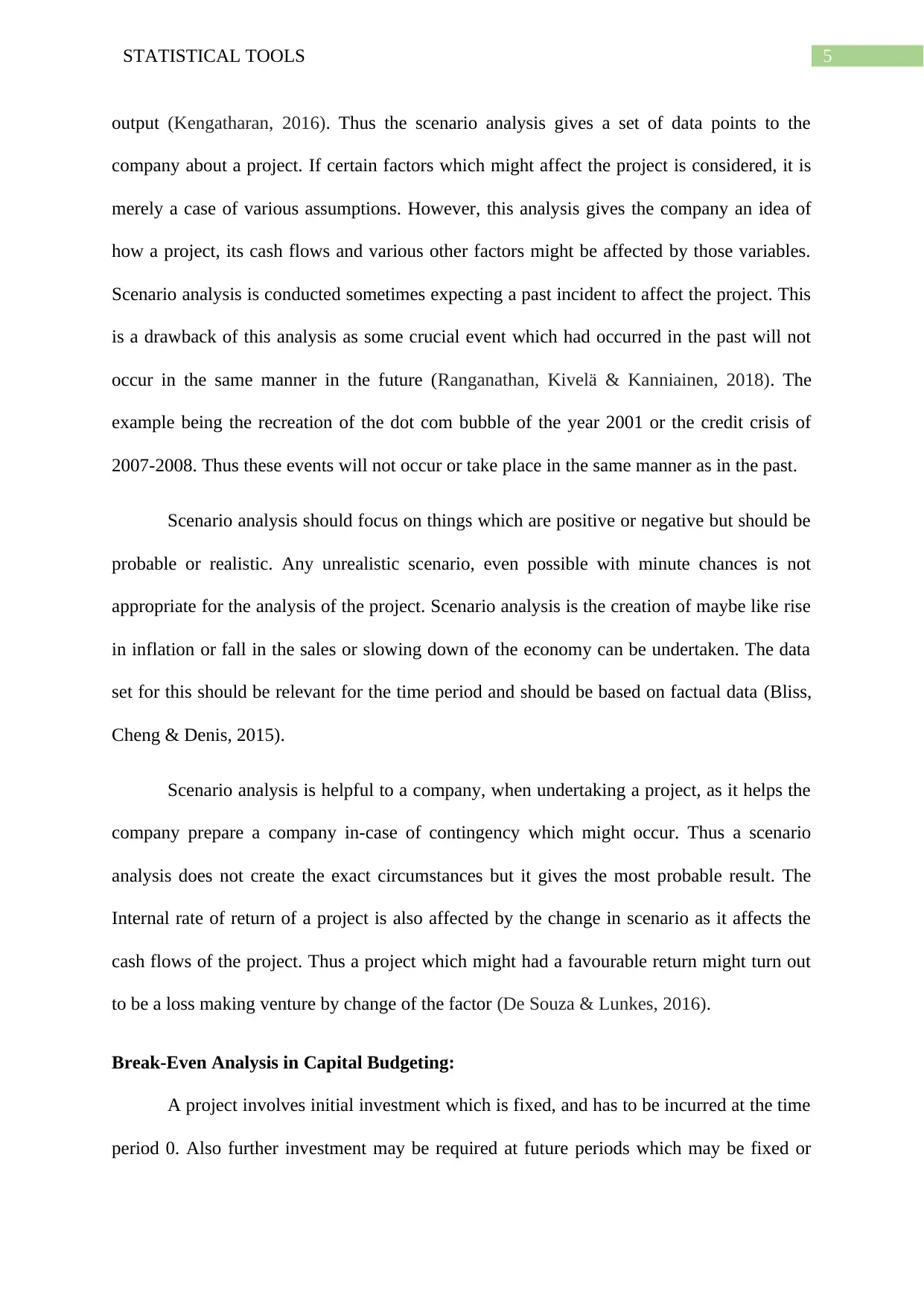
5STATISTICAL TOOLS
output (Kengatharan, 2016). Thus the scenario analysis gives a set of data points to the
company about a project. If certain factors which might affect the project is considered, it is
merely a case of various assumptions. However, this analysis gives the company an idea of
how a project, its cash flows and various other factors might be affected by those variables.
Scenario analysis is conducted sometimes expecting a past incident to affect the project. This
is a drawback of this analysis as some crucial event which had occurred in the past will not
occur in the same manner in the future (Ranganathan, Kivelä & Kanniainen, 2018). The
example being the recreation of the dot com bubble of the year 2001 or the credit crisis of
2007-2008. Thus these events will not occur or take place in the same manner as in the past.
Scenario analysis should focus on things which are positive or negative but should be
probable or realistic. Any unrealistic scenario, even possible with minute chances is not
appropriate for the analysis of the project. Scenario analysis is the creation of maybe like rise
in inflation or fall in the sales or slowing down of the economy can be undertaken. The data
set for this should be relevant for the time period and should be based on factual data (Bliss,
Cheng & Denis, 2015).
Scenario analysis is helpful to a company, when undertaking a project, as it helps the
company prepare a company in-case of contingency which might occur. Thus a scenario
analysis does not create the exact circumstances but it gives the most probable result. The
Internal rate of return of a project is also affected by the change in scenario as it affects the
cash flows of the project. Thus a project which might had a favourable return might turn out
to be a loss making venture by change of the factor (De Souza & Lunkes, 2016).
Break-Even Analysis in Capital Budgeting:
A project involves initial investment which is fixed, and has to be incurred at the time
period 0. Also further investment may be required at future periods which may be fixed or
output (Kengatharan, 2016). Thus the scenario analysis gives a set of data points to the
company about a project. If certain factors which might affect the project is considered, it is
merely a case of various assumptions. However, this analysis gives the company an idea of
how a project, its cash flows and various other factors might be affected by those variables.
Scenario analysis is conducted sometimes expecting a past incident to affect the project. This
is a drawback of this analysis as some crucial event which had occurred in the past will not
occur in the same manner in the future (Ranganathan, Kivelä & Kanniainen, 2018). The
example being the recreation of the dot com bubble of the year 2001 or the credit crisis of
2007-2008. Thus these events will not occur or take place in the same manner as in the past.
Scenario analysis should focus on things which are positive or negative but should be
probable or realistic. Any unrealistic scenario, even possible with minute chances is not
appropriate for the analysis of the project. Scenario analysis is the creation of maybe like rise
in inflation or fall in the sales or slowing down of the economy can be undertaken. The data
set for this should be relevant for the time period and should be based on factual data (Bliss,
Cheng & Denis, 2015).
Scenario analysis is helpful to a company, when undertaking a project, as it helps the
company prepare a company in-case of contingency which might occur. Thus a scenario
analysis does not create the exact circumstances but it gives the most probable result. The
Internal rate of return of a project is also affected by the change in scenario as it affects the
cash flows of the project. Thus a project which might had a favourable return might turn out
to be a loss making venture by change of the factor (De Souza & Lunkes, 2016).
Break-Even Analysis in Capital Budgeting:
A project involves initial investment which is fixed, and has to be incurred at the time
period 0. Also further investment may be required at future periods which may be fixed or
⊘ This is a preview!⊘
Do you want full access?
Subscribe today to unlock all pages.

Trusted by 1+ million students worldwide
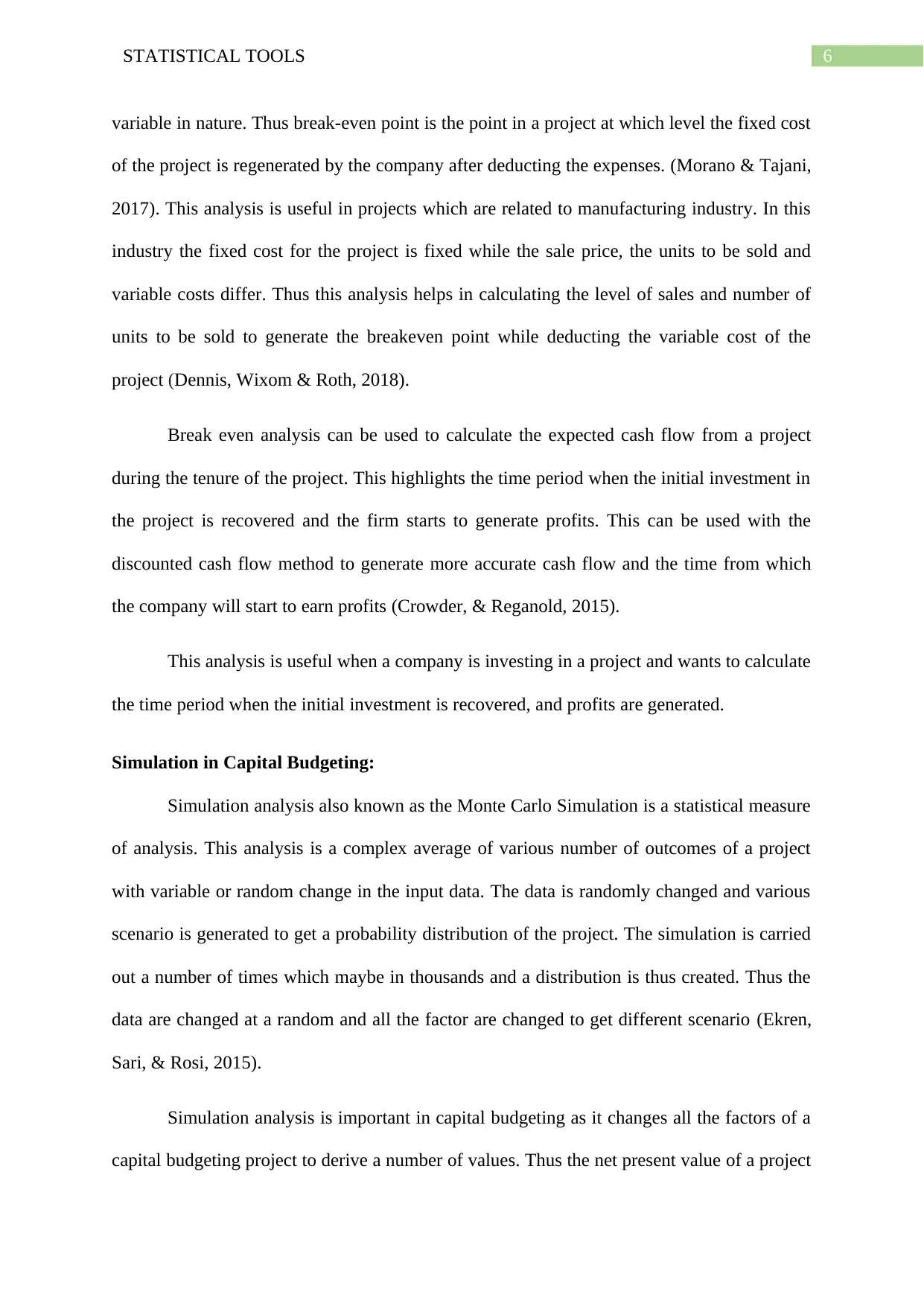
6STATISTICAL TOOLS
variable in nature. Thus break-even point is the point in a project at which level the fixed cost
of the project is regenerated by the company after deducting the expenses. (Morano & Tajani,
2017). This analysis is useful in projects which are related to manufacturing industry. In this
industry the fixed cost for the project is fixed while the sale price, the units to be sold and
variable costs differ. Thus this analysis helps in calculating the level of sales and number of
units to be sold to generate the breakeven point while deducting the variable cost of the
project (Dennis, Wixom & Roth, 2018).
Break even analysis can be used to calculate the expected cash flow from a project
during the tenure of the project. This highlights the time period when the initial investment in
the project is recovered and the firm starts to generate profits. This can be used with the
discounted cash flow method to generate more accurate cash flow and the time from which
the company will start to earn profits (Crowder, & Reganold, 2015).
This analysis is useful when a company is investing in a project and wants to calculate
the time period when the initial investment is recovered, and profits are generated.
Simulation in Capital Budgeting:
Simulation analysis also known as the Monte Carlo Simulation is a statistical measure
of analysis. This analysis is a complex average of various number of outcomes of a project
with variable or random change in the input data. The data is randomly changed and various
scenario is generated to get a probability distribution of the project. The simulation is carried
out a number of times which maybe in thousands and a distribution is thus created. Thus the
data are changed at a random and all the factor are changed to get different scenario (Ekren,
Sari, & Rosi, 2015).
Simulation analysis is important in capital budgeting as it changes all the factors of a
capital budgeting project to derive a number of values. Thus the net present value of a project
variable in nature. Thus break-even point is the point in a project at which level the fixed cost
of the project is regenerated by the company after deducting the expenses. (Morano & Tajani,
2017). This analysis is useful in projects which are related to manufacturing industry. In this
industry the fixed cost for the project is fixed while the sale price, the units to be sold and
variable costs differ. Thus this analysis helps in calculating the level of sales and number of
units to be sold to generate the breakeven point while deducting the variable cost of the
project (Dennis, Wixom & Roth, 2018).
Break even analysis can be used to calculate the expected cash flow from a project
during the tenure of the project. This highlights the time period when the initial investment in
the project is recovered and the firm starts to generate profits. This can be used with the
discounted cash flow method to generate more accurate cash flow and the time from which
the company will start to earn profits (Crowder, & Reganold, 2015).
This analysis is useful when a company is investing in a project and wants to calculate
the time period when the initial investment is recovered, and profits are generated.
Simulation in Capital Budgeting:
Simulation analysis also known as the Monte Carlo Simulation is a statistical measure
of analysis. This analysis is a complex average of various number of outcomes of a project
with variable or random change in the input data. The data is randomly changed and various
scenario is generated to get a probability distribution of the project. The simulation is carried
out a number of times which maybe in thousands and a distribution is thus created. Thus the
data are changed at a random and all the factor are changed to get different scenario (Ekren,
Sari, & Rosi, 2015).
Simulation analysis is important in capital budgeting as it changes all the factors of a
capital budgeting project to derive a number of values. Thus the net present value of a project
Paraphrase This Document
Need a fresh take? Get an instant paraphrase of this document with our AI Paraphraser
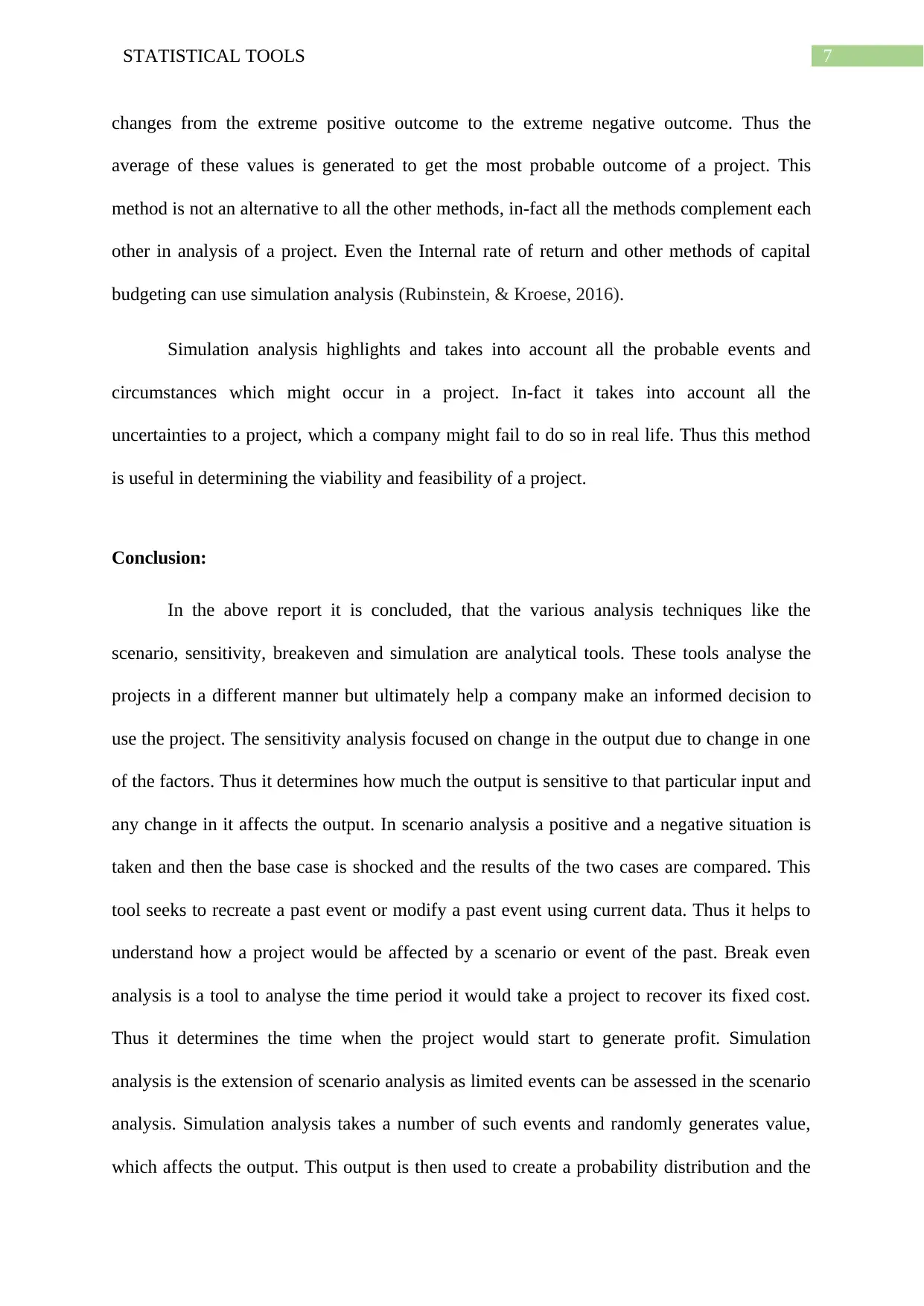
7STATISTICAL TOOLS
changes from the extreme positive outcome to the extreme negative outcome. Thus the
average of these values is generated to get the most probable outcome of a project. This
method is not an alternative to all the other methods, in-fact all the methods complement each
other in analysis of a project. Even the Internal rate of return and other methods of capital
budgeting can use simulation analysis (Rubinstein, & Kroese, 2016).
Simulation analysis highlights and takes into account all the probable events and
circumstances which might occur in a project. In-fact it takes into account all the
uncertainties to a project, which a company might fail to do so in real life. Thus this method
is useful in determining the viability and feasibility of a project.
Conclusion:
In the above report it is concluded, that the various analysis techniques like the
scenario, sensitivity, breakeven and simulation are analytical tools. These tools analyse the
projects in a different manner but ultimately help a company make an informed decision to
use the project. The sensitivity analysis focused on change in the output due to change in one
of the factors. Thus it determines how much the output is sensitive to that particular input and
any change in it affects the output. In scenario analysis a positive and a negative situation is
taken and then the base case is shocked and the results of the two cases are compared. This
tool seeks to recreate a past event or modify a past event using current data. Thus it helps to
understand how a project would be affected by a scenario or event of the past. Break even
analysis is a tool to analyse the time period it would take a project to recover its fixed cost.
Thus it determines the time when the project would start to generate profit. Simulation
analysis is the extension of scenario analysis as limited events can be assessed in the scenario
analysis. Simulation analysis takes a number of such events and randomly generates value,
which affects the output. This output is then used to create a probability distribution and the
changes from the extreme positive outcome to the extreme negative outcome. Thus the
average of these values is generated to get the most probable outcome of a project. This
method is not an alternative to all the other methods, in-fact all the methods complement each
other in analysis of a project. Even the Internal rate of return and other methods of capital
budgeting can use simulation analysis (Rubinstein, & Kroese, 2016).
Simulation analysis highlights and takes into account all the probable events and
circumstances which might occur in a project. In-fact it takes into account all the
uncertainties to a project, which a company might fail to do so in real life. Thus this method
is useful in determining the viability and feasibility of a project.
Conclusion:
In the above report it is concluded, that the various analysis techniques like the
scenario, sensitivity, breakeven and simulation are analytical tools. These tools analyse the
projects in a different manner but ultimately help a company make an informed decision to
use the project. The sensitivity analysis focused on change in the output due to change in one
of the factors. Thus it determines how much the output is sensitive to that particular input and
any change in it affects the output. In scenario analysis a positive and a negative situation is
taken and then the base case is shocked and the results of the two cases are compared. This
tool seeks to recreate a past event or modify a past event using current data. Thus it helps to
understand how a project would be affected by a scenario or event of the past. Break even
analysis is a tool to analyse the time period it would take a project to recover its fixed cost.
Thus it determines the time when the project would start to generate profit. Simulation
analysis is the extension of scenario analysis as limited events can be assessed in the scenario
analysis. Simulation analysis takes a number of such events and randomly generates value,
which affects the output. This output is then used to create a probability distribution and the

8STATISTICAL TOOLS
most probable outputs are taken. Thus all the analytical tools complement each other in the
valuation of the capital budgeting project. Thus they are used to check the viability and
feasibility of the project.
most probable outputs are taken. Thus all the analytical tools complement each other in the
valuation of the capital budgeting project. Thus they are used to check the viability and
feasibility of the project.
⊘ This is a preview!⊘
Do you want full access?
Subscribe today to unlock all pages.

Trusted by 1+ million students worldwide
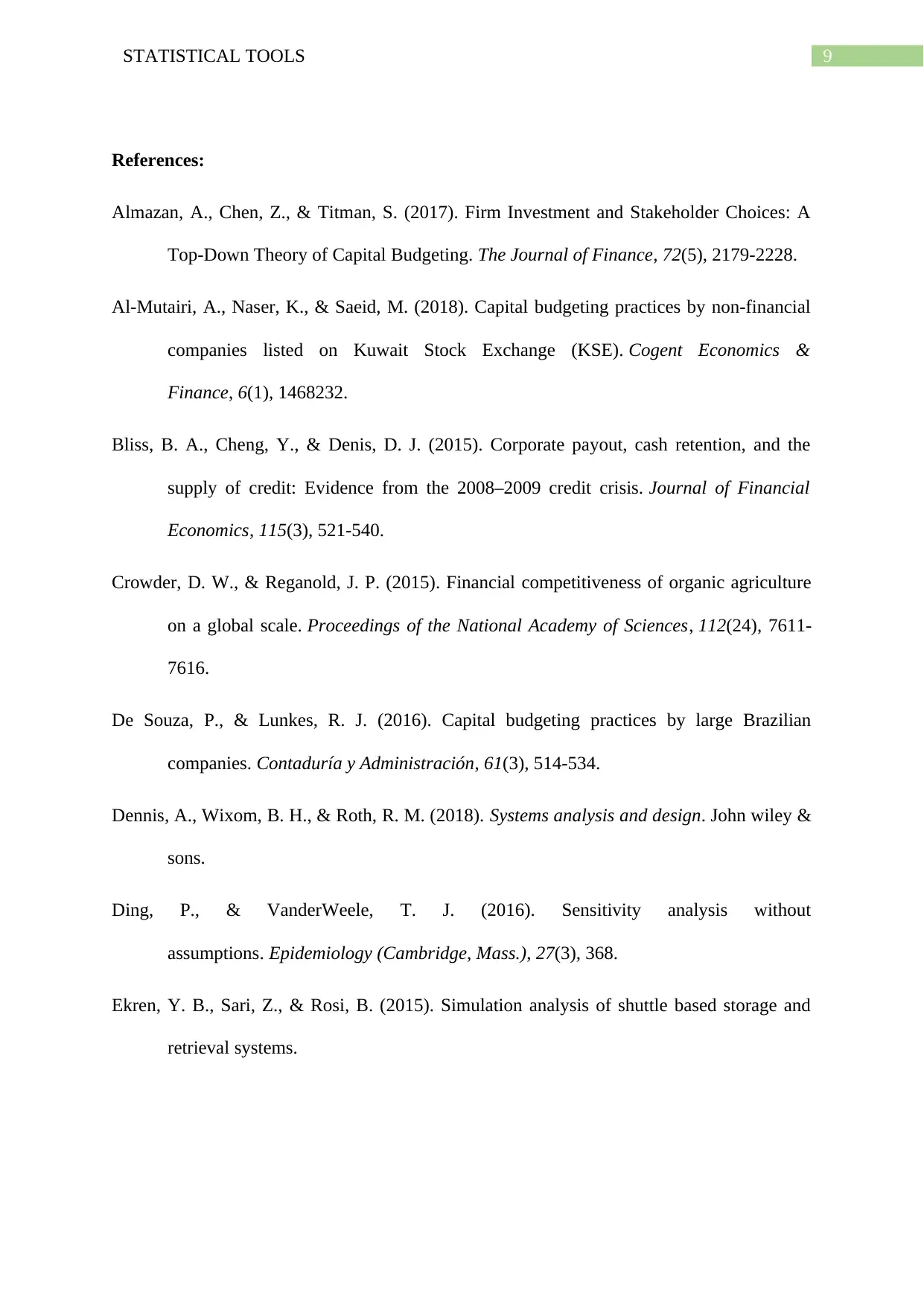
9STATISTICAL TOOLS
References:
Almazan, A., Chen, Z., & Titman, S. (2017). Firm Investment and Stakeholder Choices: A
Top‐Down Theory of Capital Budgeting. The Journal of Finance, 72(5), 2179-2228.
Al-Mutairi, A., Naser, K., & Saeid, M. (2018). Capital budgeting practices by non-financial
companies listed on Kuwait Stock Exchange (KSE). Cogent Economics &
Finance, 6(1), 1468232.
Bliss, B. A., Cheng, Y., & Denis, D. J. (2015). Corporate payout, cash retention, and the
supply of credit: Evidence from the 2008–2009 credit crisis. Journal of Financial
Economics, 115(3), 521-540.
Crowder, D. W., & Reganold, J. P. (2015). Financial competitiveness of organic agriculture
on a global scale. Proceedings of the National Academy of Sciences, 112(24), 7611-
7616.
De Souza, P., & Lunkes, R. J. (2016). Capital budgeting practices by large Brazilian
companies. Contaduría y Administración, 61(3), 514-534.
Dennis, A., Wixom, B. H., & Roth, R. M. (2018). Systems analysis and design. John wiley &
sons.
Ding, P., & VanderWeele, T. J. (2016). Sensitivity analysis without
assumptions. Epidemiology (Cambridge, Mass.), 27(3), 368.
Ekren, Y. B., Sari, Z., & Rosi, B. (2015). Simulation analysis of shuttle based storage and
retrieval systems.
References:
Almazan, A., Chen, Z., & Titman, S. (2017). Firm Investment and Stakeholder Choices: A
Top‐Down Theory of Capital Budgeting. The Journal of Finance, 72(5), 2179-2228.
Al-Mutairi, A., Naser, K., & Saeid, M. (2018). Capital budgeting practices by non-financial
companies listed on Kuwait Stock Exchange (KSE). Cogent Economics &
Finance, 6(1), 1468232.
Bliss, B. A., Cheng, Y., & Denis, D. J. (2015). Corporate payout, cash retention, and the
supply of credit: Evidence from the 2008–2009 credit crisis. Journal of Financial
Economics, 115(3), 521-540.
Crowder, D. W., & Reganold, J. P. (2015). Financial competitiveness of organic agriculture
on a global scale. Proceedings of the National Academy of Sciences, 112(24), 7611-
7616.
De Souza, P., & Lunkes, R. J. (2016). Capital budgeting practices by large Brazilian
companies. Contaduría y Administración, 61(3), 514-534.
Dennis, A., Wixom, B. H., & Roth, R. M. (2018). Systems analysis and design. John wiley &
sons.
Ding, P., & VanderWeele, T. J. (2016). Sensitivity analysis without
assumptions. Epidemiology (Cambridge, Mass.), 27(3), 368.
Ekren, Y. B., Sari, Z., & Rosi, B. (2015). Simulation analysis of shuttle based storage and
retrieval systems.
Paraphrase This Document
Need a fresh take? Get an instant paraphrase of this document with our AI Paraphraser
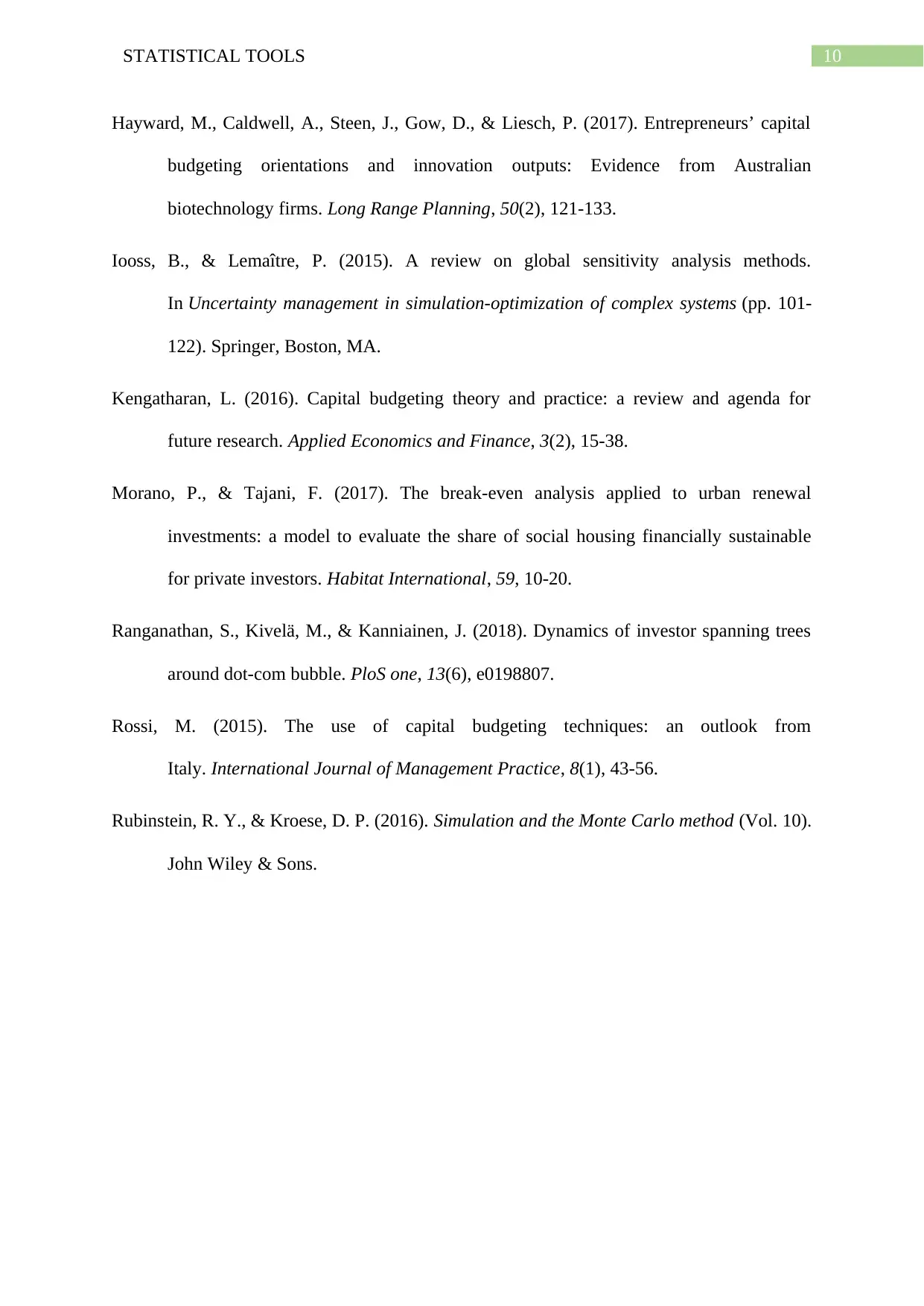
10STATISTICAL TOOLS
Hayward, M., Caldwell, A., Steen, J., Gow, D., & Liesch, P. (2017). Entrepreneurs’ capital
budgeting orientations and innovation outputs: Evidence from Australian
biotechnology firms. Long Range Planning, 50(2), 121-133.
Iooss, B., & Lemaître, P. (2015). A review on global sensitivity analysis methods.
In Uncertainty management in simulation-optimization of complex systems (pp. 101-
122). Springer, Boston, MA.
Kengatharan, L. (2016). Capital budgeting theory and practice: a review and agenda for
future research. Applied Economics and Finance, 3(2), 15-38.
Morano, P., & Tajani, F. (2017). The break-even analysis applied to urban renewal
investments: a model to evaluate the share of social housing financially sustainable
for private investors. Habitat International, 59, 10-20.
Ranganathan, S., Kivelä, M., & Kanniainen, J. (2018). Dynamics of investor spanning trees
around dot-com bubble. PloS one, 13(6), e0198807.
Rossi, M. (2015). The use of capital budgeting techniques: an outlook from
Italy. International Journal of Management Practice, 8(1), 43-56.
Rubinstein, R. Y., & Kroese, D. P. (2016). Simulation and the Monte Carlo method (Vol. 10).
John Wiley & Sons.
Hayward, M., Caldwell, A., Steen, J., Gow, D., & Liesch, P. (2017). Entrepreneurs’ capital
budgeting orientations and innovation outputs: Evidence from Australian
biotechnology firms. Long Range Planning, 50(2), 121-133.
Iooss, B., & Lemaître, P. (2015). A review on global sensitivity analysis methods.
In Uncertainty management in simulation-optimization of complex systems (pp. 101-
122). Springer, Boston, MA.
Kengatharan, L. (2016). Capital budgeting theory and practice: a review and agenda for
future research. Applied Economics and Finance, 3(2), 15-38.
Morano, P., & Tajani, F. (2017). The break-even analysis applied to urban renewal
investments: a model to evaluate the share of social housing financially sustainable
for private investors. Habitat International, 59, 10-20.
Ranganathan, S., Kivelä, M., & Kanniainen, J. (2018). Dynamics of investor spanning trees
around dot-com bubble. PloS one, 13(6), e0198807.
Rossi, M. (2015). The use of capital budgeting techniques: an outlook from
Italy. International Journal of Management Practice, 8(1), 43-56.
Rubinstein, R. Y., & Kroese, D. P. (2016). Simulation and the Monte Carlo method (Vol. 10).
John Wiley & Sons.
1 out of 11
Related Documents
Your All-in-One AI-Powered Toolkit for Academic Success.
+13062052269
info@desklib.com
Available 24*7 on WhatsApp / Email
![[object Object]](/_next/static/media/star-bottom.7253800d.svg)
Unlock your academic potential
Copyright © 2020–2025 A2Z Services. All Rights Reserved. Developed and managed by ZUCOL.





